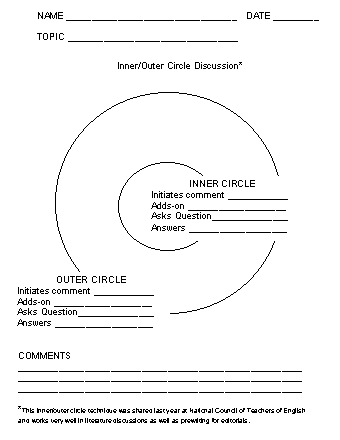Circular Reasoning?
Inner/Outer Circle
A Prewriting Activity for Editorials
Goals:
1. To prepare students to write an editorial or position paper
2. To encourage students to contemplate multiple views on a controversial
issue
3. To encourage students to listen to the views of others and to respond to them
4. To develop oral speaking skills and impromptu responses in a group
discussion
5. To develop skills in supporting one's opinion with facts and examples

 View and print this diagram in the Adobe Acrobat PDF format.
View and print this diagram in the Adobe Acrobat PDF format.
Get help on viewing
PDF files
Procedures
1. Choose a controversial issue for class discussion.
2. Ask students to fold a sheet of notebook paper lengthwise and to
title each side of fold either Pro or Con.
3. Ask students to list on the folded sheet arguments for and against
the chosen topic (students working individually for 10 minutes). Students
will use these sheets in small group discussion described below.
4. Divide students into four groups.
5. Arrange enough student desks to accommodate two groups into two circles
as in the attached diagram.
6. Place student group number one in inner circle.
7. Place student group number two in outer circle.
8. Remaining students listen and take notes during this part of the
exercise.
9. Explain inner/outer rules to group.
a. For fifteen uninterrupted minutes, inner circle will
independently discuss the chosen issue. Students will be marked on
responses listed on the attached diagram (initiates comment, adds-to
another's comment, asks question, answers question).
b. During the first fifteen minutes, group number two takes notes
and prepares to join discussion but does not speak until after the
first fifteen minutes.
c. For the next fifteen minutes, group two (Outer Circle) contributes
to the discussion by asking questions and initiating comments, etc.
Both groups now scored according to diagram.
10. After the second fifteen-minute discussion, groups
one and two exchange places (group number two becoming inner circle;
group number one becoming outer circle.
11. Repeat steps 8 and 9 above.
12. After second discussion periods, groups three and four offer comments
and oral evaluation of the discussion of groups one and two.
13. Groups three and four exchange places with groups one and two.
14. Repeat steps 8 and 9 above.
15. Follow-up: Students write editorials using traditional format on
chosen topic.
Notes:
1. Alternative grouping: Two controversial issues may
be assigned to the class, one to groups one and two and the second issue
to groups three and four. This method would reduce the possibility of
boredom of repeated discussions on same topic.
2. Steps 1-4 above may be done on class period prior to Inner/Outer
circle discussions. The students may then use homework time to find
facts and examples to back up their arguments.
3. Students may choose their own positions on the issue, or the teacher
may assign a position in order to encourage students to examine both
sides of the issue and to encourage students to anticipate opposing
arguments.
4. Each student is scored individually on the attached diagram by using
a check to record each response.



